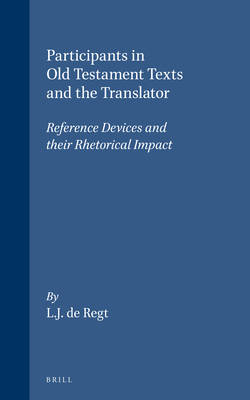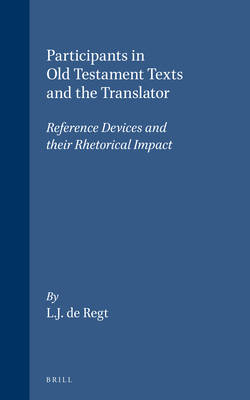
- Afhalen na 1 uur in een winkel met voorraad
- Gratis thuislevering in België vanaf € 30
- Ruim aanbod met 7 miljoen producten
- Afhalen na 1 uur in een winkel met voorraad
- Gratis thuislevering in België vanaf € 30
- Ruim aanbod met 7 miljoen producten
Zoeken
Participants in Old Testament Texts and the Translator
Reference Devices and Their Rhetorical Impact
de Regt
€ 163,45
+ 326 punten
Omschrijving
In Biblical Hebrew texts, individuals and groups are referred to according to specific rules and conventions. How are participants introduced into a text and traced further? When is this done by means of proper names, when by nouns, and when by pronominal elements? In this book, examples from many Biblical passages illustrate the patterns involved. These rules help to solve problems of participant reference in controversial passages.
But it is not enough to know who are the participants; one needs to establish why they are referred to the way they are. Main characters in a text are referred to differently from others. Certain devices of participant reference help to indicate paragraph boundaries.
Unusual references to participants aim to be noticed and have rhetorical impact. Proper names may occur where one would have expected a pronominal element (or vice versa). Participants may be mentioned in an unexpected order. Special attention is given to such unusual reference devices and the rhetorical strategies involved: climax, suspense and implicit comment. In a translation, these strategies should still be as clear as they are in the source text. So how have reference devices been handled in ancient and modern translations?
But it is not enough to know who are the participants; one needs to establish why they are referred to the way they are. Main characters in a text are referred to differently from others. Certain devices of participant reference help to indicate paragraph boundaries.
Unusual references to participants aim to be noticed and have rhetorical impact. Proper names may occur where one would have expected a pronominal element (or vice versa). Participants may be mentioned in an unexpected order. Special attention is given to such unusual reference devices and the rhetorical strategies involved: climax, suspense and implicit comment. In a translation, these strategies should still be as clear as they are in the source text. So how have reference devices been handled in ancient and modern translations?
Specificaties
Betrokkenen
- Auteur(s):
- Uitgeverij:
Inhoud
- Aantal bladzijden:
- 132
- Taal:
- Engels
- Reeks:
- Reeksnummer:
- nr. 39
Eigenschappen
- Productcode (EAN):
- 9789023234449
- Verschijningsdatum:
- 1/01/1999
- Uitvoering:
- Hardcover
- Formaat:
- Genaaid
- Afmetingen:
- 155 mm x 235 mm
- Gewicht:
- 348 g

Alleen bij Standaard Boekhandel
+ 326 punten op je klantenkaart van Standaard Boekhandel
Beoordelingen
We publiceren alleen reviews die voldoen aan de voorwaarden voor reviews. Bekijk onze voorwaarden voor reviews.











